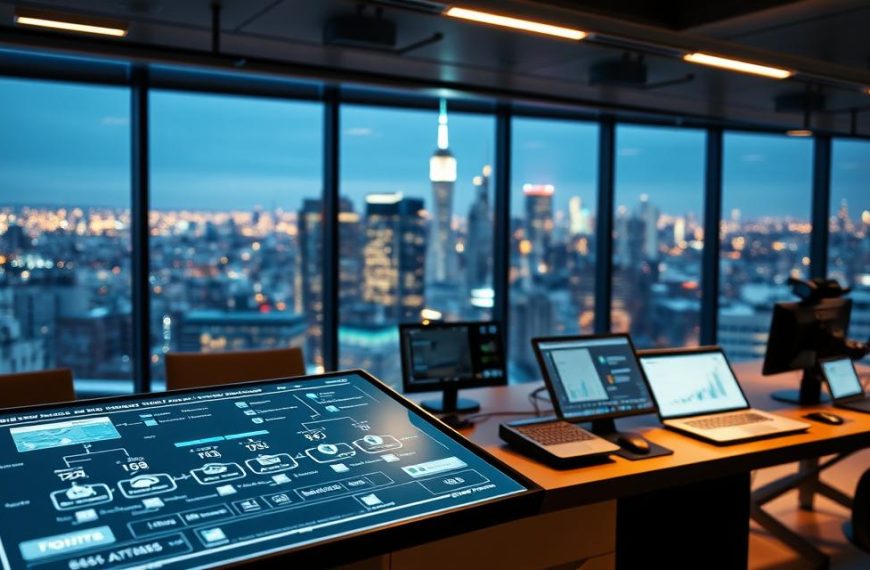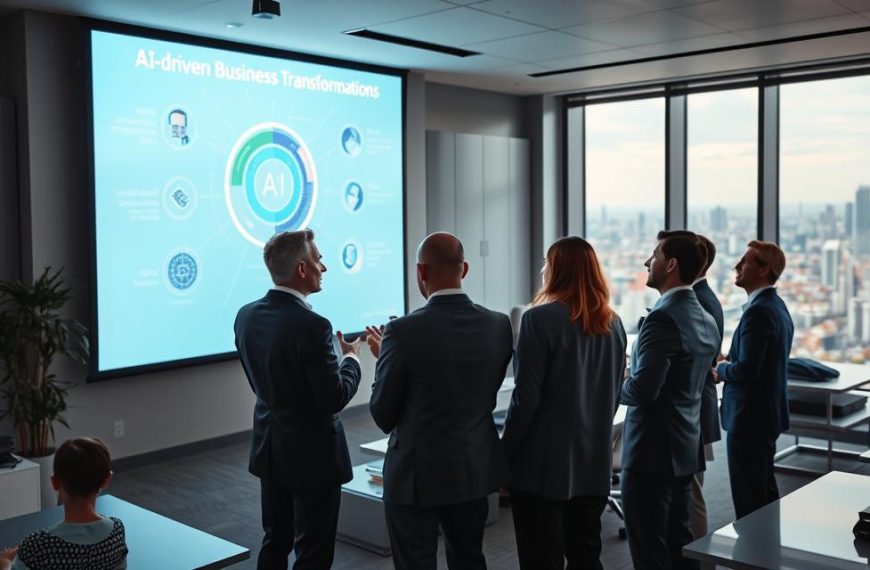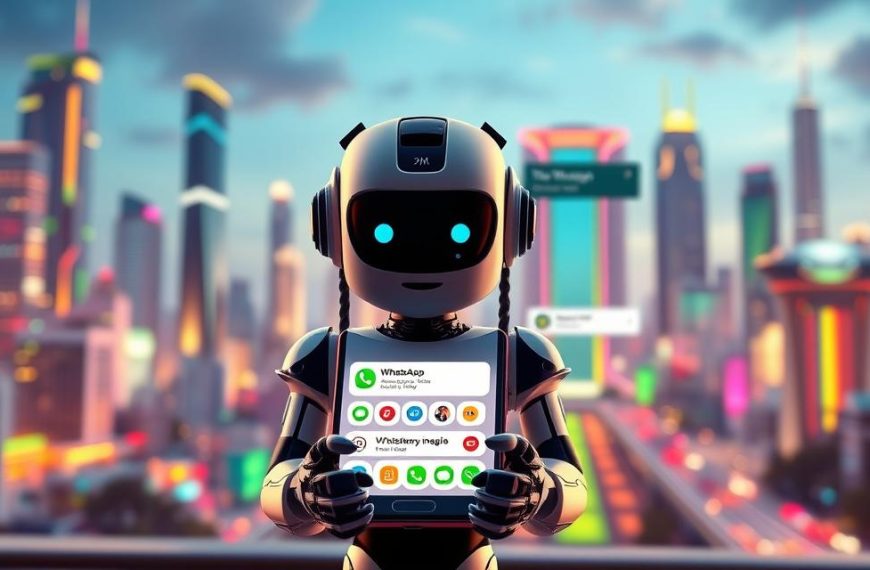The business world is changing fast as companies focus on making things more efficient. The global AI market is expected to hit £1.4 trillion by 2030. This means businesses are working hard to use smart systems to make their work easier and better.
Studies show a mix of progress and worries. While 83% of big companies use machine learning, 71% of workers are scared about losing their jobs. This mix of tech advancement and job fears is what we see in enterprise AI case studies. It’s seen in healthcare and improving supply chains.
Smart companies are facing these issues head-on. For example, Tesco uses smart algorithms to manage stock with 98% success. Banks use AI to cut fraud checks by 40%. These examples show AI can help people, not just replace them.
Looking at 2024’s AI adoption trends, we see three key areas. These are AI in customer service, using data for green projects, and making AI fairer. Each area shows how tech can solve real problems and address worries about automation.
How Businesses Are Using Artificial Intelligence in 2024
AI adoption is speeding up worldwide. Companies are seeing real benefits from AI-driven decision making and tackling ethical issues. Over 44% of businesses have seen efficiency gains, similar to Tesco’s 44% drop in energy use with smart grids. This change is backed by AI startup funding hitting over $103bn in 2024, showing strong faith in AI’s role in business.
Key Drivers Behind Widespread AI Adoption
Three main reasons drive AI adoption in companies. First, cutting costs – like ASOS’s 18% drop in inventory costs with predictive stock management. Second, staying ahead in customer-facing areas. Third, better AI ROI metrics help justify tech spending.
“The average enterprise AI project now delivers ROI within 14 months, down from 23 months in 2022.”
Industry-Specific Implementation Patterns
Different sectors have unique AI uses:
- Retail: ASOS uses machine learning and RFID to forecast fashion trends 8 weeks ahead
- Banking: HSBC’s deep learning spots fraud in 120 million transactions an hour
- Manufacturing: Siemens uses computer vision for instant defect checks on production lines
These examples highlight how ethical AI implementation shapes sector-specific solutions. Banks focus on security and transparency, while manufacturers aim to improve efficiency and reduce errors.
1. AI-Driven Predictive Analytics Revolution
Businesses in all fields are using AI predictive analytics to turn data into valuable insights. This new tech lets companies see market changes early. It changes how they use resources and handle risks.
Retail Inventory Transformation
Retailers today face a big challenge: keeping the right amount of stock. Thanks to advanced AI, they can now guess what customers will buy. This is based on sales history, weather, and social media trends.
Demand Forecasting Breakthroughs
ASOS, a leading fashion brand, cut overstock by 18% with AI. Their system looks at over 50 things every day. This includes:
- Regional fashion trends
- Supplier lead times
- Competitor pricing shifts
| Metric | Traditional Methods | AI Forecasting |
|---|---|---|
| Accuracy Rate | 68% | 89% |
| Inventory Turnover | 4.2x/year | 6.8x/year |
| Stockout Events | 22/month | 7/month |
Financial Risk Management Evolution
Banks are using neural networks to study customer transactions. HSBC’s fraud detection system checks £9 billion daily. It spots suspicious activity in just 0.8 seconds.
“Our deep learning models achieved 92% detection accuracy by analysing 137 behavioural markers per transaction.”
Credit Assessment Innovations
Lenders are now using new data in credit scores:
- Utility payment histories
- Educational background patterns
- Device usage characteristics
This machine learning personalisation has sped up loan approvals by 23%. It keeps default rates under 2.1% for all involved.
2. Hyper-Personalisation Through Machine Learning
Today, companies are changing how they talk to customers. They use machine learning to understand what people like in a big way. This makes experiences special for each person, helping to keep them coming back and spending more.
E-commerce Recommendation Engines
Big online stores are using smart systems to guess what you might want to buy. John Lewis’s Style Assistant is a great example. It looks at lots of things you’ve done online to suggest clothes that match your style.
John Lewis’s Tailored Shopping Experiences
John Lewis’s AI helps you make choices faster by suggesting things that fit your needs. It knows about the weather and what’s in season. This has made more people buy what they’re shown, up by 35%.
Dynamic Pricing Strategies
Machine learning helps set prices that change as things happen. Uber is a good example. It changes prices every 15 seconds based on traffic, how many drivers are around, and how busy it is.
- Real-time traffic conditions
- Driver availability hotspots
- Historical demand patterns
Uber’s Surge Pricing Algorithms
Uber uses lots of data to figure out when to charge more. It looks at traffic and how many drivers are around. This way, it can set prices before it gets really busy.
Hotel Chain Revenue Management
Big hotels are using AI to set room prices. They look at things like local events, what other hotels are charging, and the weather. This helps them keep rooms full and make more money.
| Data Input | Impact on Pricing | Optimisation Frequency |
|---|---|---|
| Local event calendars | +22% rate adjustments | Hourly updates |
| Competitor pricing | 12% market alignment | Real-time monitoring |
| Weather forecasts | 9% demand prediction | Daily revisions |
This smart way of setting prices helps hotels stay busy. They keep about 89% of their rooms filled. The system learns from things like cancellations and what guests say to get better at setting prices.
3. AI-Powered Cybersecurity Solutions
Modern businesses face 4.3 million cyberattacks daily. AI-driven defence systems are now essential, not optional. They use machine learning and ethical AI implementation to fight digital threats.
Real-Time Threat Detection Systems
Neural networks can now analyse 2TB of security data every hour. They spot attack patterns that humans might miss for weeks. Darktrace’s Antigena network is a great example, using unsupervised learning to stop zero-day attacks early.
Darktrace’s Enterprise Protection
This system saw an 89% reduction in response times in MIT tests. Its algorithms evolve quickly, adapting to new networks in 24 hours. It keeps a 99.98% detection accuracy in both cloud and on-premise systems.
Automated Incident Response
BAE Systems’ security platform shows how cybersecurity automation works. It handles 500,000 daily alerts without human help. AI sorts threats fast, 53% quicker than humans.
BAE Systems’ Security Orchestration
Their SOC workflows use explainable AI, tackling ethical AI implementation issues. It automatically fights threats and keeps detailed records. These records meet GDPR and CCPA standards.
“AI isn’t replacing security teams – it’s giving them superhuman capabilities to combat industrial-scale attacks.”
4. Intelligent Process Automation in Operations
Today’s businesses are seeing huge gains in efficiency thanks to intelligent process automation. This combines the accuracy of machines with the insight of humans. It lets companies make quick decisions and keep quality high in both making things and moving goods.
Manufacturing Quality Control
Rolls-Royce’s Production Line Optimisation
Rolls-Royce’s aerospace team used computer vision to check turbine blades fast. This AI-driven method cut down on mistakes by 40%, as Manufacturing Global reported. The tech checks 12,000 points in seconds, spotting issues humans miss.
Logistics Route Planning
DHL’s AI-Driven Delivery Networks
DHL’s logistics now save 4.7 million miles a year with smart route planning. Their system looks at weather, traffic, and fuel prices in real-time. This smart move cut fuel use by 17%, Logistics Management said.
| Application Area | Technology Used | Key Metric | ROI Period |
|---|---|---|---|
| Aerospace Manufacturing | Computer Vision Systems | 40% Defect Reduction | 14 Months |
| Package Logistics | Route Optimisation AI | 17% Fuel Savings | 11 Months |
| Automotive Assembly | Robotic Process Automation | 28% Throughput Increase | 18 Months |
These examples show clear AI ROI metrics, with most seeing returns in under 14 months. Leaders are now focusing on automation that boosts efficiency now and benefits them in the long run.
5. Sustainable Business Practices Through AI
Today, companies see environmental care as key to success. Sustainable AI solutions help manage resources better. They aim to keep operations efficient while protecting the planet.
Energy Consumption Reduction
Tesco shows how machine learning can cut energy use. Their smart refrigeration systems use IoT to track:
- Temperature changes
- Store foot traffic
- Weather
This effort led to a 44% drop in energy use. It also cut 26,000 tonnes of CO₂ emissions yearly. Tesco’s sustainability leader says:
“Our AI predicts cooling needs 72 hours ahead. This saves energy without risking food safety.”
Tesco’s Smart Refrigeration Systems
The supermarket uses AI to:
- Adjust compressor cycles
- Set defrost times automatically
- Notify maintenance about issues
Waste Management Optimisation
Veolia’s recycling plants use ethical AI to improve waste sorting. Their robots sort 1,600 items per minute with:
- Multi-spectral imaging
- Material analysis
- Learning algorithms
This tech has raised sorting accuracy to 98%. It keeps 240,000 tonnes of waste out of landfills each year.
Veolia’s Recycling Plant AI
The company has integrated:
- Quality checks
- Dynamic conveyor routes
- Carbon credit modules
| Company | AI Application | Environmental Impact | ESG Benefit |
|---|---|---|---|
| Tesco | Smart refrigeration | 26k tonnes CO₂ reduction | SDG 13 (Climate Action) |
| Veolia | Waste sorting robots | 98% recycling accuracy | SDG 12 (Responsible Consumption) |
These examples show sustainable AI solutions can make a big difference. They support ethical AI implementation and help companies meet ESG goals. Now, these technologies are part of ESG reports, showing sustainability progress to investors and regulators.
6. Workforce Augmentation Strategies
Today’s businesses are changing how we see human talent. They use AI-driven decision making to blend machine smarts with human creativity. This mix lets people do more creative work and solve problems better.
Revolutionising Talent Acquisition
Smart companies are now using workforce augmentation tools to find the best candidates. They look beyond what’s on a CV. Unilever’s AI recruitment system is a great example of this new way.
Unilever’s Candidate Screening Breakthrough
Unilever cut hiring time by 75% with a video analysis tool. It checks:
- How well candidates communicate
- 25,000 tiny facial expressions
- If their answers fit the job
“Our AI filters out 90% of applicants, but humans decide who gets hired”
Optimising Workforce Efficiency
Leaders use AI-driven decision making to boost work efficiency. Siemens shows how this works in their factories.
Siemens’ Smart Factory Systems
Siemens saw a 31% boost in productivity. They did this with:
- IoT sensors watching how workstations are used
- Machine learning to improve workflow
- AI to design better factory layouts
They make sure these systems watch what’s being done, not who’s doing it. This keeps things fair and transparent.
Conclusion
Businesses in 2024 are using AI to change how they work. At Amazon, AI helps manage stock better. At HSBC, AI spots fraud. These examples show how AI makes things more efficient.
The World Economic Forum says 97 million new AI jobs will appear by 2025. This means companies need to rethink how they train their staff.
Good companies use AI for routine tasks but keep humans for creative work. Siemens and Unilever are examples. They let AI do energy calculations so their engineers can innovate.
They also check if AI projects are worth it. This is important for keeping customers happy and keeping data safe.
Companies that use AI wisely stay ahead. They also help the planet. As AI gets better, companies must update their rules and train their people.
They should also be ready for new technologies like quantum computing and edge AI. This will help them stay ahead in the future.













